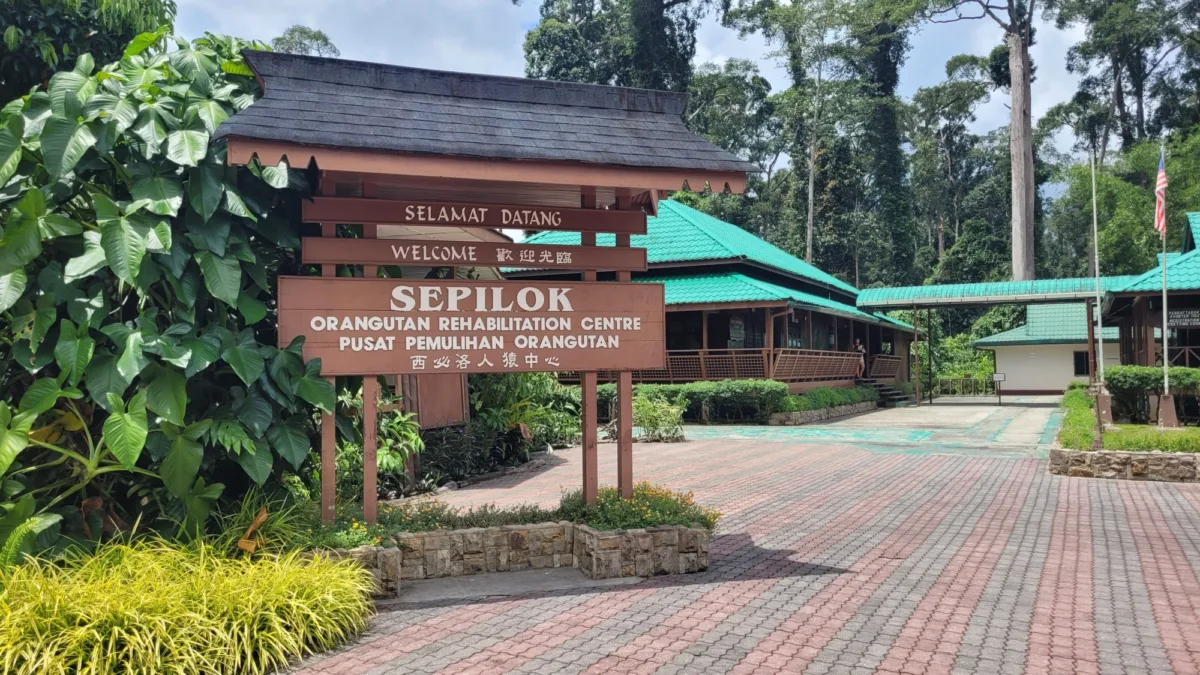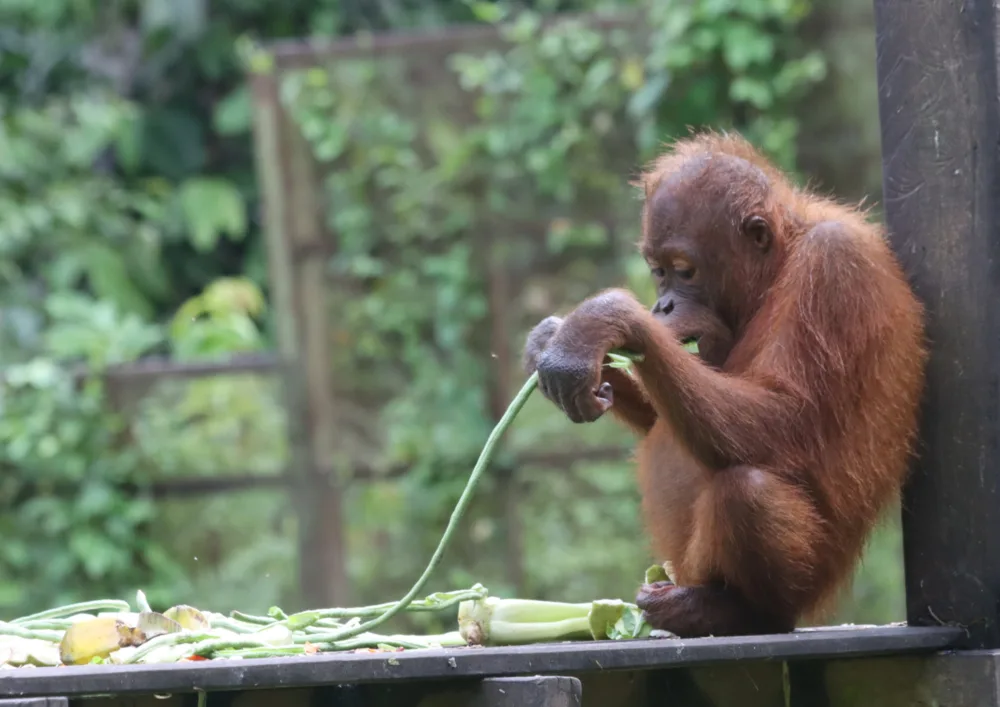If you plan a trip to Borneo, a morning at the Sepilok Orangutan Rehabilitation Centre becomes a pilgrimage for anyone who cares deeply about wildlife and conservation. Sepilok, situated about 25 km west of Sandakan in Sabah, Malaysian Borneo, is the world-famous rehabilitation project. Here, orphaned and injured Bornean orangutans receive training in the skills necessary for survival and eventually return to the surrounding Kabili-Sepilok Forest Reserve when they are ready.

Why Sepilok Matters
Sepilok opened in the 1960s. Its original mission was to rescue baby orangutans left orphaned by logging, plantations, or the illegal pet trade. Consequently, over several decades, it has blossomed into a globally recognised centre. The centre successfully combines direct rescue and rehabilitation with essential public education. This model helped shape modern orangutan conservation efforts worldwide. Furthermore, the surrounding Kabili-Sepilok Forest Reserve, which consists mainly of lowland rainforest, functions as both the “classroom” and the eventual release area for rehabilitated individuals.
What to Expect on the Visit
Sepilok’s structure minimizes human contact with the orangutans while still allowing visitors to observe the animals responsibly. Specifically, the visitor facilities include an outdoor feeding platform, raised walkways that extend into the forest, and an indoor nursery viewing area. You can observe young orangutans through glass in this area. These viewing points enable you to watch the animals’ natural behaviours without disrupting the crucial rehabilitation process.
The centre conducts daily public feeding sessions. These sessions, typically held mid-morning and mid-afternoon, offer the best opportunities to see several orangutans come to the platform. Plan your arrival for an early start or time your visit around the 10:00 and 15:00 sessions to achieve the best viewing experience. Generally, tickets admit you for the entire day; therefore, you can return for the second feeding if you wish to do so.
The Rehabilitation Process
When the centre receives babies and injured orangutans, staff medically assess them and begin training them in vital survival skills. This training includes climbing, foraging, nest-building, and social interaction with other orangutans. As the animals progress through the stages, they transition from intensive nursery care to larger enclosures. Later, they enter soft-release programs within the reserve. The ultimate goal is always to return animals to the wild when they are ready; the centre does not keep them as exhibits. Sepilok’s successful model strongly emphasizes minimal human imprinting while effectively teaching the necessary natural behaviours.

Practical Info (Hours, Tickets, Rules & Tips)
The centre is typically open daily, usually from 09:00 to 16:00, with the two aforementioned feeding sessions taking place. However, always check the centre’s or Sabah wildlife pages before your visit, because hours and seasonal schedules occasionally change.
Visitors pay a modest entrance fee. Fees vary for Malaysian versus non-Malaysian visitors and for children versus adults. The staff strictly asks visitors to follow all rules: no touching the animals, no feeding them, no loud noises, and no food or drinks inside the viewing areas. These rules exist specifically to protect the animals and safeguard the delicate rehabilitation process. You must lock away bags and food as instructed by the staff.
You should bring light clothing, insect repellent, and a rain jacket, as Borneo rain is unpredictable. Additionally, a decent zoom lens or binoculars enhances the viewing experience. Leave food, water bottles, and tripods locked away if the centre requires it. Be prepared to stay quiet and patient. Nature does not follow a predictable schedule, but the feeding times offer the most reliable windows for observation.
Getting There & Where to Stay
Sepilok sits close to Sandakan, which serves as the usual gateway for visitors. Many visitors choose to stay in Sandakan itself or at smaller lodges situated near Sepilok. Transfers and day tours originating from Sandakan are both common and easy to arrange. Furthermore, if you stay nearby, you can easily combine your visit to Sepilok with other compelling wildlife stops. This lets you create a full day of activity.
Nearby Attractions (Make It a Wildlife Day)
You will find the Bornean Sun Bear Conservation Centre (BSBCC) within easy walking distance of Sepilok. The BSBCC rehabilitates rescued sun bears and makes an excellent companion visit. The Rainforest Discovery Centre (RDC) offers canopy walkways, birding opportunities, and forest trails. These features allow you to experience the reserve from different, exciting perspectives. Consider combining these attractions with a Sandakan city tour or a river cruise for a truly varied itinerary.
Responsible Visiting & Supporting Conservation
Sepilok functions as a rehabilitation centre, not a zoo. Therefore, the best approach involves treating it with the utmost respect. Move quietly, obey the staff’s instructions, and keep all interactions strictly observational. Furthermore, if you want to help beyond simply visiting, consider several ways to contribute.
You can make donations or adopt an orangutan through reputable programmes. Buying local services, such as guides, transport, and lodging, supports the community and helps reduce the pressure to convert forest into plantations. Lastly, you must avoid tours or experiences that advertise “holding,” “feeding directly by hand,” or photo opportunities with the animals. These activities are harmful to the orangutans and are often illegal. Orangutan charities and educational organisations linked with Sepilok often manage formal adoption or support programmes if you desire a deeper form of support.
Sample Half-Day Itinerary
- 08:30 — Leave Sandakan and arrive at Sepilok.
- 09:30 — Visit the nursery and interpretation centre.
- 10:00 — Watch the morning feeding session from the platform.
- 11:00 — Walk the nearby trails or visit the Sun Bear Centre.
- 14:30 — Return for the afternoon feeding (if you stayed through the day), or head back to Sandakan with inspiring wildlife memories.
